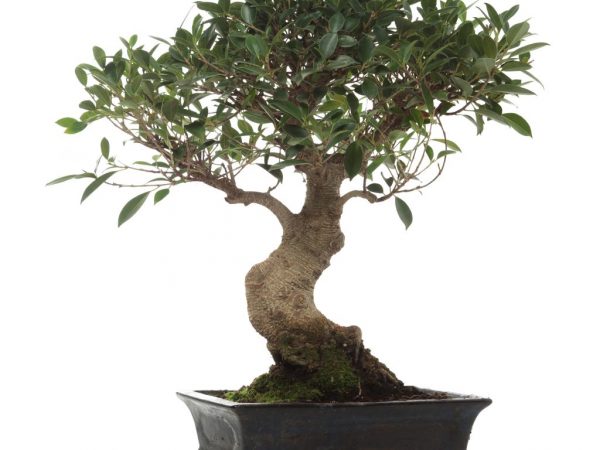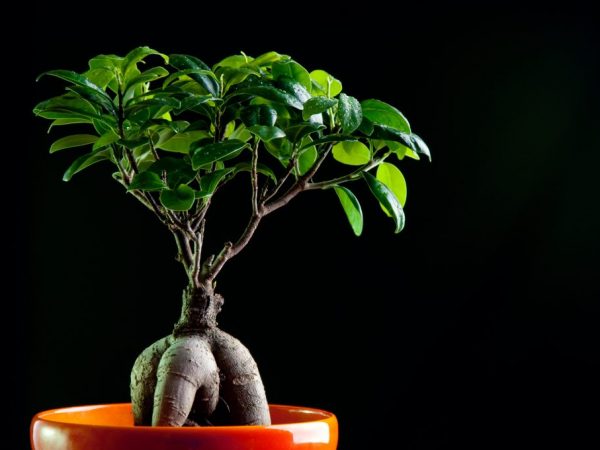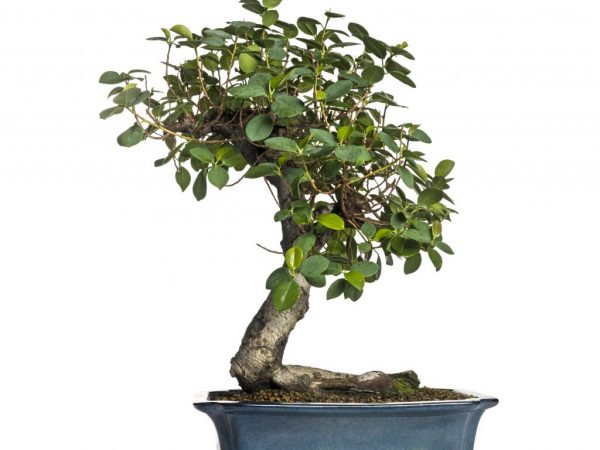Rules for caring for the ficus Retuza (Dull)
Growing a Blunted Ficus at home does not require much effort. This is an unpretentious plant that quickly adapts to environmental conditions. Retusa is often used to create bonsai. A living miniature sculpture looks harmonious and graceful.

Rules for caring for the ficus Retuza (Blunted)
In the wild, the ficus Retuza reaches a height of 20 m. At home, such a huge tree cannot be grown. Indoor ficus Obtuse (Ficus retusa) has a low trunk, grayish bark and fleshy leaves.
Description
Ficus Retusa (Ficus retusa) came to us from tropical Asia, it also grows in Australia, but there it is called Leaves-Pur.
It is a tree with a smooth, thick, gray-brown trunk. It has a branched dense crown and powerful aerial roots. The leaves of Retusa are leathery, oval, with a pointed edge.
There is a variegated variety of Blunted Ficus. It has variegated leaves. Wood is very often used to decorate rooms; caring for it is somewhat more difficult than for ordinary one.
At home, ficus can be grown from bonsai seeds. This is not difficult to do, but you have to try.
Care
It is not difficult to grow a dull ficus at home: it is an unpretentious houseplant. Retuza takes root well, it pleases the eye with its unusual appearance all year round.
When growing ficus, you need to know about the optimal conditions for its maintenance:
- sufficient illumination;
- air temperature at the level of 20-25 ° С;
- moderate watering;
- regular feeding;
- neutral acid-base balance of the soil.
The plant does not tolerate drafts. This must be taken into account when choosing a place for him in the room.
Regular pruning of the tree is required to maintain the appearance and shape of the crown. The crown grows slowly, it is pruned in the last days of winter or early spring. Special care is required for living bonsai sculpture. It differs little from the usual one, but more attention is required to trim the crown.
In the warm season, it is best to take the ficus out into the open air.
Temperature control and lighting
Ficus is a tropical tree, so it loves light and warmth. The conditions of the room are quite suitable for its healthy development.

Ficus loves warmth and light
Retusa requires a high level of illumination. In winter, you need to take care of additional artificial lighting. In the summertime, you need to protect the juicy green leaves from direct sunlight: they burn the leaves, causing them to dry out. In a room, it is best to place a tub with a tree on a window on the south or west side. In the summer afternoon, the plant must be transferred to the shade.
A room temperature of 20-25 ° C is optimal for a dull ficus. In winter, the temperature in the room should not drop below 15 ° C: this is detrimental to the tree. It is important to protect the plant from drafts.
Watering and feeding
Watering regime plays an important role in the formation of a healthy plant. How to properly water a dull ficus?
- In spring, summer and early autumn, the plant is watered every 3-5 days.It is important that the topsoil has time to dry out.
- With the onset of the first cold weather, the ficus is watered every 10 days.
In summer, it is best to water the plant early in the morning or in the evening after sunset. It is imperative to change the watering regime at the onset of cold weather, otherwise the plant will shed its leaves.
Dull ficus loves moisture very much. It is sprayed with water from a spray bottle both in summer and winter.
Retuzu is fertilized with organic and mineral mixtures. The mixtures are prepared following the instructions. Top dressing is applied during the period of growth activation: from early spring to early autumn.
Ficus soil
Retusa grows only in neutral, light soils that are good for air and moisture. You can buy soil for the plant at a garden store or make your own mixture at home.
Ficus substrate is prepared using the following recipes:
- in a ratio of 2: 2: 2: 1, mix turf and deciduous soil, peat and sand;
- combine peat, greenhouse soil and sand in a ratio of 1: 2: 0.5;
- for young ficuses and cuttings, a substrate is made, mixing humus, deciduous, soddy soil and sand in equal proportions.
Charcoal is a good component for soil substrates. When planting, drainage is necessarily created in order to avoid stagnation of moisture and the development of putrefactive processes. Broken brick or expanded clay is used as drainage.
Reproduction

The plant is easy to propagate at home.
There are two ways to reproduce a Blunted Ficus:
- seeds;
- cuttings.
Both are easy to implement at home. Retusa seeds can be purchased at a flower shop or harvested from an adult tree. Growing will take a long time. Seeds sprout for a long time. Sowing is best done at the end of July. For bonsai, ficus is grown from seeds.
It is most popular to propagate the plant by cuttings. It's very simple:
- a young shoot is cut off from the shoot;
- wash the slice under water to remove milk secretions;
- plant the cutting in the substrate (use the recipe for the mixture for cuttings);
- cover the appendix with a glass or plastic cap (this will create a greenhouse environment).
Before planting in the ground, the cutting can be rooted. To do this, it is simply placed in water with a slice. The liquid must be constantly changed so that it does not stagnate and bloom. When the first roots become visible on the shoot, you can plant it in the ground. You need to choose a small pot, up to 9 cm in diameter.
Dull ficus requires transplantation every year. It is held in late February or early March. When the tree grows large, it is replanted every 2-3 years. In large pots and tubs, only the topsoil can be replaced.
Growing problems
Even a novice florist can grow Retusa. The plant adapts well to environmental conditions.
Problems with the plant appear when the rules of care and conditions of detention are violated. The most common situations are:
- Leaf fall. The causes of the problem are a decrease in air temperature, a draft, excessive soil moisture, a change in location. Falling foliage can also provoke excess fertilizer.
- Leaves fall off gradually. The situation arises due to excessive watering, increased soil acidity.
- The edges of the leaves turn yellow. The cause of the problem is root system diseases. Roots can be attacked by rot or pests. The situation arises with improper watering, irregular and insufficient feeding.
- Young leaves are small, and old ones turn yellow. The reason is dry air or poor feeding.
- Leaves wrinkle and dry out. Direct sunlight provokes the situation. They cause burns.
The most common pests are spider mites, thrips, and scale insects. They infect the dull ficus, causing diseases. You can get rid of pests with the help of insecticides.
Ficus Retuza can become the pride of any grower. This tree can really be grown in a greenhouse, winter garden and apartment.If you follow the simple rules of care and maintenance, the plant will grow and delight the owners with its beauty for a long time. For bonsai, the tree is grown from seed. This is easy to do at home. Bonsai maintenance includes standard measures, but more attention needs to be paid to crown pruning.


